Performances
Writing & other encounters
Content types
Tags
- Plays (7)
- Warlike Collage (3)
- The Dybbuk (3)
- Twenty Two Pictures (3)
- Cheruta (3)
- Grace (3)
- Ruthie Osterman (2)
- Theatre du soleil (1)
- Arian Mnushkin (1)
- Iphigenia in Aulis (1)
- Euripides (1)
- Sophocles (1)
- Antigone (1)
- Performance Practices & Research (1)
- I am. I am. I am (1)
- ZSPERA'42 (1)
- Postal Delivery to God (1)
- Babylon Beyond Borders (1)
- Bush Theatre (1)
- Live Stream (1)
- Up Next (1)
Links
Links
Babylon Beyond Borders
live streamed performance happening simultaneously in four countries.
Bush Theatre, London | Harlem Stage, New York
Market Theatre Lab, Johannesburg | Pequeno Ato, São Paulo
February, 2019
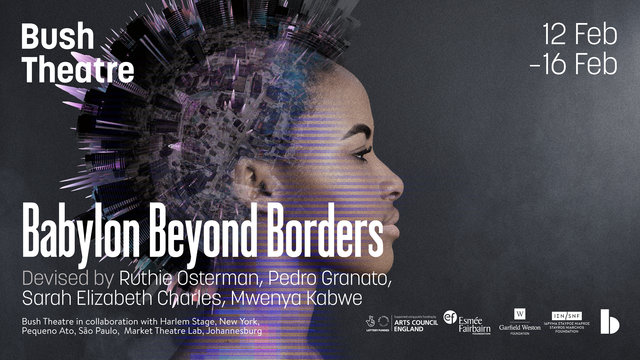
“Babylon Beyond Borders is not only an absolute must-see for its theatrical ingenuity and originality, but it is also a desperately important play for its fresh outlook, which celebrates distance from a hegemony dominated by fear of the other.”
The Upcoming ★★★★★
“Babylon Beyond Borders is a momentous technical feat.”
The Stage ★★★★
“Seamlessly blending four live streams into one performance that works not only in the theatre’s around the globe, but also on a YouTube livestream. Making it accessible to anyone and everyone around the world and that alone is what makes Babylon Beyond Borders an enormous and original success”
Theatre full stop ★★★★
“Babylon Beyond Borders is an absolutely superb piece of theatre: completely relevant, so ambitious and pulled off so well. It’s also pulled off by a nearly 100% female cast and crew! I was left with a very real sense that this is what theatre should be.”
Four extraordinary theatres, each deeply rooted in their own community, explore their relationship to home, language and migration. A Brazilian activist at the Pequeno Ato Theatre in São Paulo performs with a chorus of women from Shepherd’s Bush, London. Musicians at Harlem Stage in New York City act out the experiences of students at the Market Theatre Lab in Johannesburg in a celebration of the possibility and power of cross border encounters.
Project Partners
Bush Theatre (London, UK) – a world-famous home for new plays and an internationally renowned champion of playwrights.
Harlem Stage (NYC, USA) – an award-winning performing arts centre that features diverse local, national, and global artists in music, film, opera, theatre, dance and literature.
Pequeno Ato (São Paulo, Brazil)- award-wining young independent theatre focusing on creating new dramaturgy and contemporary aesthetics.
Market Theatre Lab (Johannesburg, South Africa) was operating as an independent, non-racial theatre during the country’s apartheid regime. The theatre provides a platform for professional performing and visual arts repertoire.
Presented as part of the Up Next programme by Bush Theatre and Battersea Arts Centre in partnership with Artistic Directors of the Future.
Watch the full live streamed performance Babylon Beyond Borders on the Bush Theatre YouTube Channel
Devised by Ruthie Osterman, Sarah Elizabeth Charles, Pedro Granato and Mwenya Kabwe.
London Creative team:
Director
Ruthie Osterman
Live Stream Producer
Heather Pasfield
Writer & Dramaturg
Lighting design:
Rajiv Pattani
Music:
Sarah Elizabeth Charles
Set design:
Ding Musa
Movement Director:
Rachael Nanyonjo
Costumes:
Samantha Murphy
Production manager:
Aniela Zaba
Stage Manager
Ellie Dear
Assistant Stage Manager
Lucy Rees
Actors:
Afia Abusham | Carol Walton | Lydia Buckelman
Women’s Chorus:
Maureen Natumi| Lieve Carchon| Aubrey Seader| Mediah Ahmed| Jessica Manu| Melissa Saint
Ilaria Ciardelli| Christaline Mckay| Pauline Singh| Tilail Negussie Mekuria| Sophie McCartney
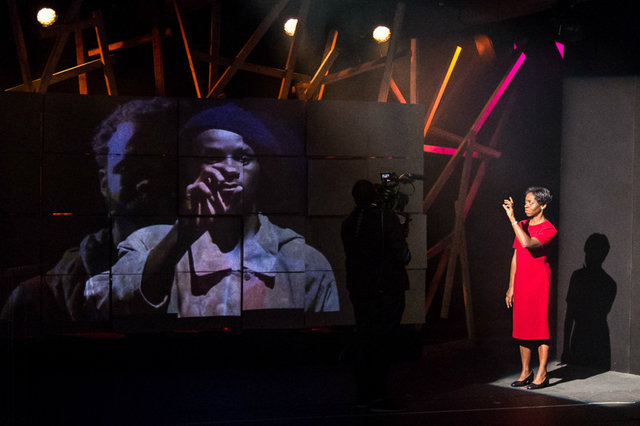 Image by Wasi Daniju
Image by Wasi Daniju
About the performance:
Babylon Beyond Borders was presented as part of the Up Next programme at the Bush Theatre.
Up Next is a leadership programme championing the next generation of visionary culturally diverse leaders and artists. As part of this programme, Executive Producer Tobi Kyeremateng and Artistic Director Ruthie Osterman were given the opportunity to take over the Bush Theatre for a season and programme the space. They created BABYLON a two-week season with Babylon Festival in the first week, curated by Tobi Kyeremateng and celebrating the contemporary influence and experience of black and brown people. And Babylon Beyond Borders in the second week – a live streamed performance happening simultaneously in four countries, created by Ruthie Osterman.
Vision
The vision behind Babylon Beyond Borders was to connect the Bush Theatre’s local community to other communities around the world by creating international collaboration that would happen simultaneously in various countries.
The idea was to challenge the way we create theatre and to work collaboratively with artists from around the globe, using modern technological and digital tools for communication. The main goal was to create a significant encounter between theatres and artists around the world and to create work that could generate social and political change. The decision to use the live stream method came out of the will to find an alternative encounter to the physical one which is limited by physical borders and the privilege of travelling abroad.
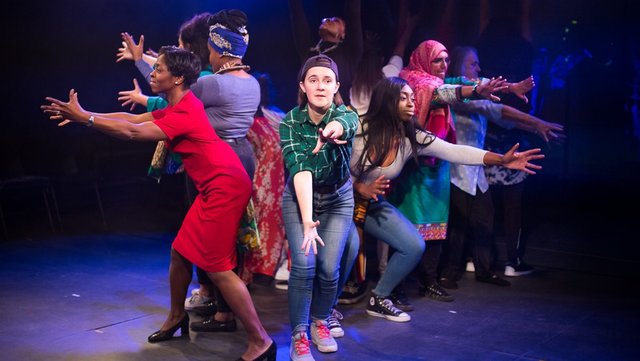 Image by Wasi Daniju
Image by Wasi Daniju
The nature of the collaboration – working process
Between 5th to 9th November 2018, the Bush Theatre hosted an intensive Research & Development workshop with the international partners. In the workshop, the lead artists from London, Johannesburg, New York and São Paulo devised the content of the performance, learnt and developed how to incorporate the live stream element and agreed on a working method. The workshop ended with an open sharing for Bush staff which was live streamed on social media.
To read Ruthie’s blog about the workshop, please visit: Workshop’s blog
Babylon Beyond Borders – R&D workshop at the Bush Theatre
Rehearsals – Babylon Beyond Borders
Synopsis
Four extraordinary theatres, each deeply rooted in their own community, explore their relationship to home, language and migration. Deconstructing the biblical story Tower of Babel, the four companies present stories of four contemporary towers; The Grenfell Tower in London, The Ponte City Tower in Johannesburg, Ocupação 9 de Julho in São Paulo and the World Trade Centre in USA. Through the stories of those towers, they raised questions about home and boundaries. A Brazilian activist at the Pequeno Ato Theatre in São Paulo performs with a chorus of women from Shepherd’s Bush. Musicians at Harlem Stage in New York City act out the experiences of students at the Market Theatre Lab in Johannesburg in a celebration of the possibility and power of cross border encounters.
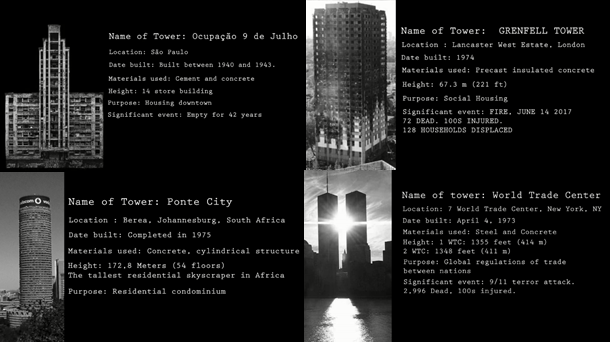
 Audiences see themselves live on screen (Clockwise: NYC, São Paulo, Johannesburg, London)
Audiences see themselves live on screen (Clockwise: NYC, São Paulo, Johannesburg, London)
Women’s Chorus
Babylon Beyond Borders incorporated an intergenerational chorus of 11 women from the Bush Theatre’s local community, coming from vast backgrounds, and age 21 to 71. The chorus was a combination of professional and non-professional performers who were interested in the project and were willing to explore their personal connection to home, exile and migration.
The cast and creatives of Babylon Beyond Borders represent the beautiful diversity of Shepherd’s Bush and sees London as a modern Babel. This is a celebration of cultures and identities. There were 19 languages presented on stage and on screen: Portuguese, Italian, Amharic, French, West Indian Patois, Swahili, isiZulu, Kikuyu, Kiswahili, Urdu, Punjabi, Polish, Spanish, German, Dutch, Italian, London Back slang and English.
“Now, the beauty of linguistic diversity is that it reveals to us just how ingenious and how flexible the human mind is. Human minds have invented not one cognitive universe, but 7,000 – there are 7,000 languages spoken around the world. And we can create many more – languages, of course, are living things, things that we can hone and change to suit our needs. The tragic thing is that we’re losing so much of this linguistic diversity all the time. We’re losing about one language a week, and by some estimates, half of the world’s languages will be gone in the next hundred years.”
(Monologue from the play Babylon Beyond Borders)
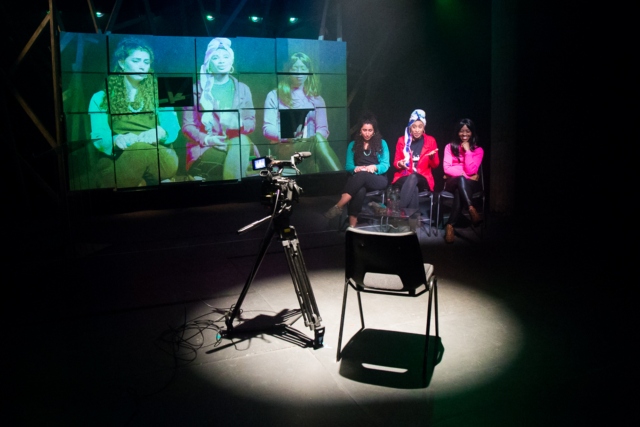 /still_images]Image by Wasi Daniju
/still_images]Image by Wasi Daniju
Press & Reviews
UK press
Skin Deep Magazine – an interview with Ruthie Osterman
Radio- London Live- an interview with Ruthie Osterman
TV- An interview with Ruthie Osterman on Sky News
Alondon (Israeli magazin, in Hebrew)
USA press
BRAZIL press
SA press
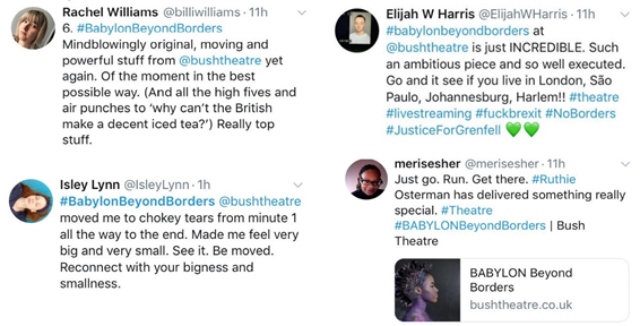
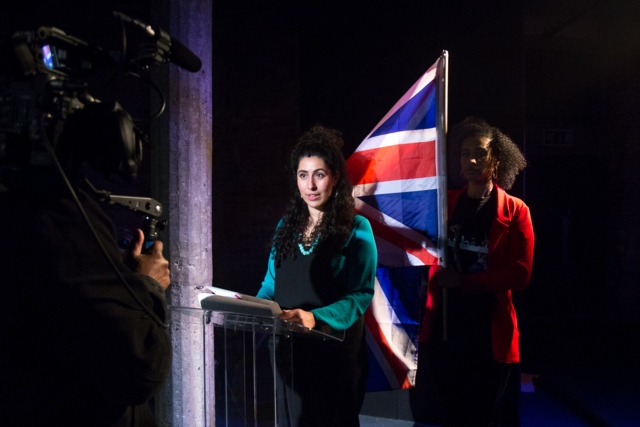
The UP NEXT initiative is funded by the Arts Council England Sustained Theatre grant. Babylon Beyond Borders is generously supported by Stavros Niarchos Foundation, the Esmée Fairbairn Foundation and Garfield Weston Foundation.
I am. I am. I am.
Royal Central School of Speech & Drama, London , 2013
Intermedial Performance by Ruthie Osterman.
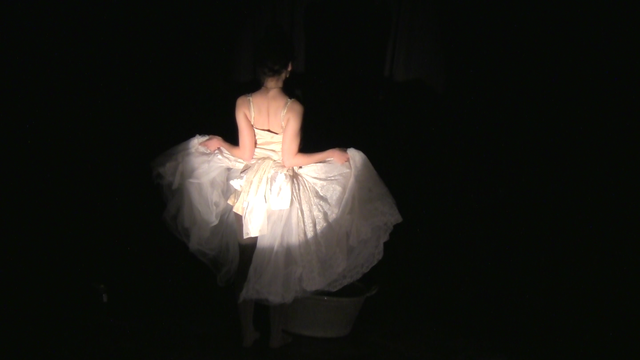
“I took a deep breath and listened to the old brag of my heart. I am, I am, I am.”
(Sylvia Plath, The Bell Jar)
This intermedial performance practice explores the encounter between body, image and object.
A point of friction between the mortal and the immortal.
In a fragile world full of memories, images, texts and movements, one self appears and disappears, born and vanishing again.
A negative of something which is never known.
I prayed to God to wake up in the morning, even though I had never gone to sleep.

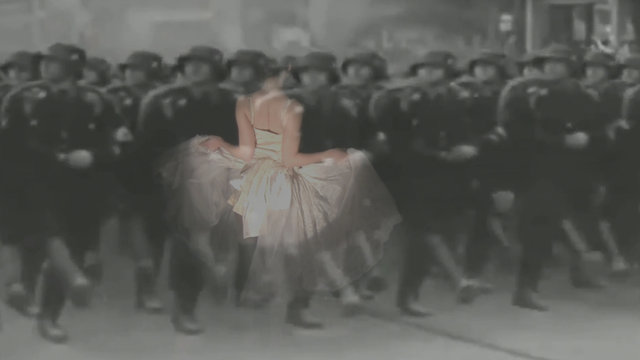
Created and performed by:
Ruthie Osterman
Artistic consultant & tutoring:
Dr. Experience Bryon, Jo Scott, Jessica Hartley.
Media consultant
Ken Mizutani and Roberto Puzone.
Lighting design
Phil Rowe
Texts
From “The Unnamable” by Samuel Beckett & “The unabridged journals of Sylvia Plath”
Music
“Shine on you crazy diamond” / Pink Floyd
Video operator
Reut Wizenberg.
Light operator
Hedda S.Rui.
Performing “The other hand”
Joao Telmo.
About the practice
This intermedial performance-practice was created as part of my MA studies in Performance Practices & Research at the Royal Central School of Speech & Drama and presented as part of the Brink Festival in June 2013. In my Practice as Research project I explored the relationship between intermediality and the subject matter of memory in a Live performance. Beside my artistic knowledge and experience as a theatre director and a performer, I was exploring a new field of intermediality in performance: “the meeting point in-between the performers, the observers, and the confluence of media involved in a performance at a particular moment in time. The intermedial inhabits a space in-between the different realities that the performance creates.”(Chapple & Kattenbelt 2006:12)
As part of my research, I applied the philosophical concepts of Henri Bergson’s Memory and of Jacques Derrida’s différance as a lense through which I asked creative questions and constructed the work.
The intermedial performance “I am. I am. I am.” constituted the practical part of my Practice as Research project and is accompanied by a thesis which I wrote as part of my MA studies.
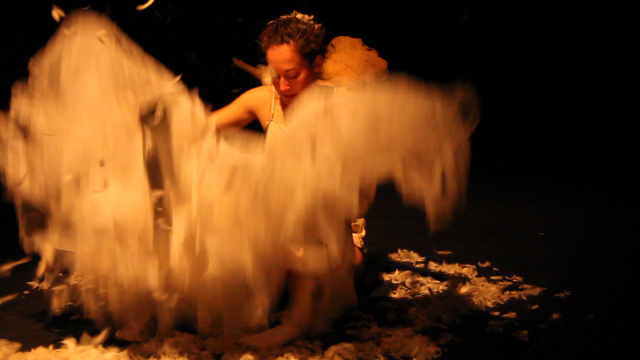
“What might have been and what has been
Point to one end, which is always present.
Footfalls echo in the memory
Down the passage which we did not take
Towards the door we never opened…” (T.S. Eliot, Four Quartets)
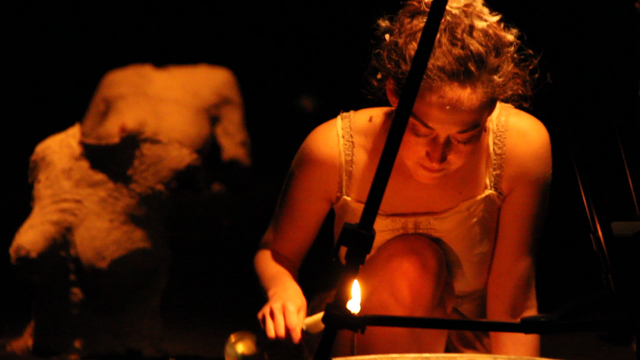
About the performance:
I performed on stage with different objects, four live cameras, a projector and a big screen hanging from the ceiling. The performance’s theme was memory and identity and it was composed from different elements related to my identity. The audience was located in front of the stage. I used the software Modul8, a vision mixer connected to a computer and the projector in order to project the live and the pre-recorded images on the screen and create the combination between them. The software was operated live during the performance by a technical operator.
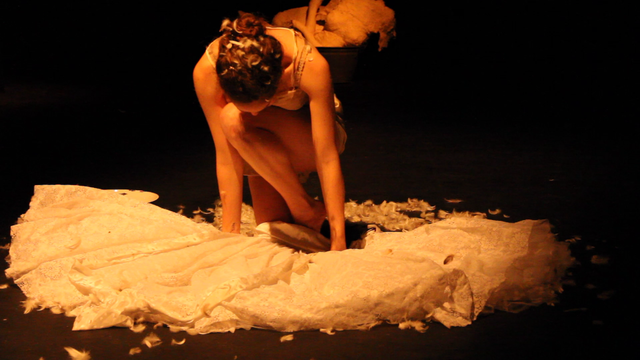
Creating the Intermedial-Encounter – A glimpse into the creative process:
Content (Memory, Tradition and Nature)
I have drawn my practice from the contents of my memories, traditional and historical heritage and nature and chose particular forms of objects, images and my body to represent these in performance.
In my practice, my memory constitutes the main source with which I had entered the studio. The virtual pasts were actualized in my practice and co-existed with the present action. Examples of such memories are my fear from the Nazis’ steps I used to imagine I heard as a child and the bread my grandmother used to feed me.
An additional kind of content was symbols and rituals from my Jewish religious tradition , such as Netilat Yadaym – the act of washing the hands before eating bread, salting the bread during the Kiddush ceremony on Shabbat and the Caparot ritual – a ritual for cleansing your guilt by spinning a chicken over your head and praying that your blame be transferred to the animal.
The third content was elements from nature. While the first two kinds of contents came directly from my inner world, the third one came from the external world. I mainly used materials from nature such as water, fire, salt and feather. The chosen rituals relate to change in their traditional value and take place in order to move from one state to another. I took them out of their context and placed them in relation to other elements in order to create an ‘in-between’ tension. I chose to use very simple and old elements beside the modern and complex media equipment; in this way I composed an intermedial encounter from variety of ‘in-betweens’.
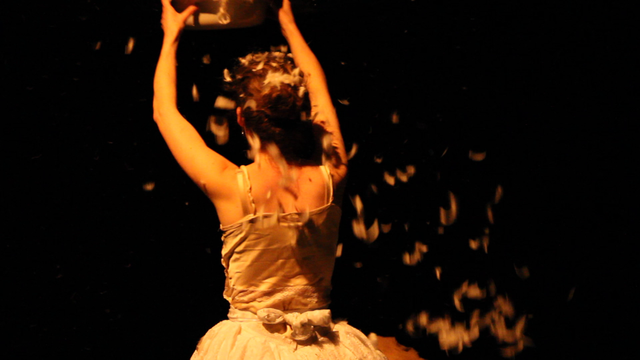
Forms (object, image and body)
Object
The objects which I used ‘came to me’; they emerged from memories or were found by chance. An example of such an object is the bowl I used in my performance. On May 2013, I visited the props-warehouse in Central school of speech and Drama, which is a small room full of junk, and by chance I found two old metal bowls that attracted me. Only when I got to the studio I realized that one of the metal bowls had an engraving of the Star of David at its bottom. It was very surprising and even shocking; how did this bowl get here?
My initial purpose for using a bowl came from my childhood memory in a bath; but the object I found evoked something else. I suddenly realized why it seemed familiar. I saw these kinds of bowls in Atlit detainee camp in Israel. The object connected my private memory to the historical/collective memory of my nation and a new encounter emerged.
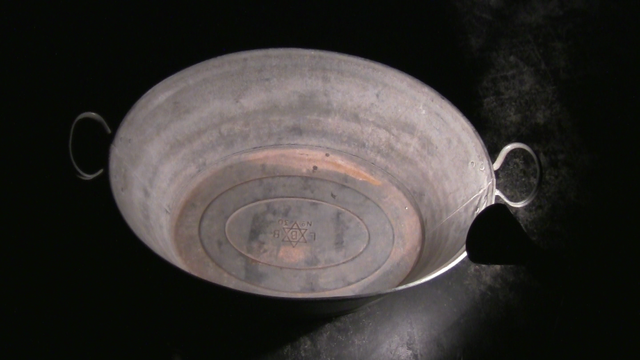
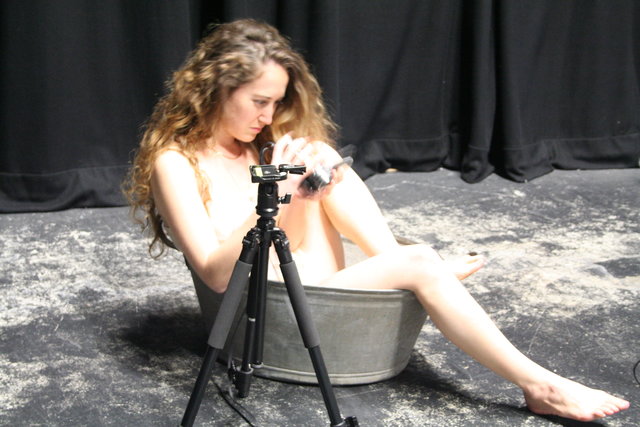
Photos taken from the rehearsal of “I am. I am. I am.” , Experimental-studio, CSSD.
Beyond the function of an object in activating memory, it has a significant role in creating the ‘in-between’ of the intermedial encounter. The object functioned as an actual form beside its virtual image (For example, the bread on the table and its close-up on the screen) and as an actual form beside the actual body (the torso-cast of my body and my live body). The unique objects of my body-casts aimed to empower the encounter between the three forms which allegedly represent the same identity and fragmentation of identity.
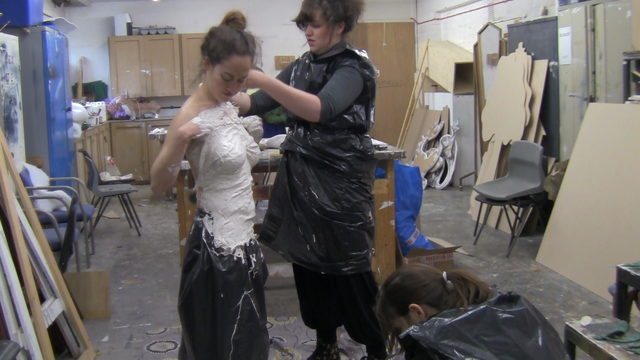
Photo taken from the process of creating the body-cast.
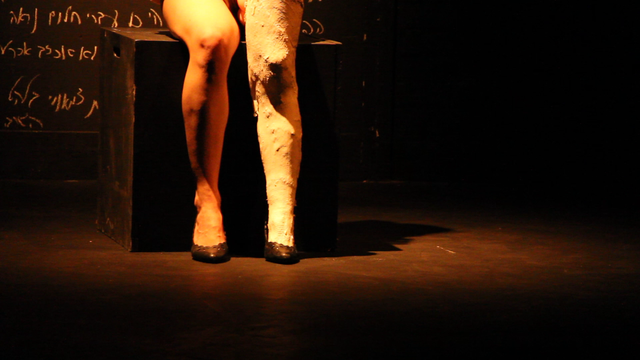
Photo taken of using one of the body-cast in the performance.
Image
There are three main kinds of images which I created and explored in my practice:
1. Pre- recorded image
I used pre-recorded images which emerged from my memory and represented different dimensions and times than those that existed on stage. What guided me in choosing these pre-recorded images was the notion of correspondence. The pre-recorded images co-responded to something which existed in the present moment on stage and created the tension of the ‘in-between’. My exploration of the co-existence of a virtual image of the past and an actual action in the present on stage is based on the Bergsonian concept of the co-existence of past and present.
2. Live image – I created live images from the actions happening on stage. The actions and the frames had been chosen carefully from the materials which emerged in the rehearsal and which had been composed for stage. I aimed to strengthen the tension and the differentiation between the actual action and its virtual form by playing with proximity and distance, exposure and hiding. By using live images and not only pre-recorded materials I revealed the differentiation within the live moment. It is not only a tension between different temporalities (like past and present) but also within the present moment itself.
3. Two-layers image – a combination of a pre-recorded image and the live image
The combination of two images together and the dissolving between different times and spaces within one image. Following Derrida’s différance, I tried to see to it that each element will keep ‘within itself the mark of the past element’ and ‘letting itself be vitiated by the mark of its relation to the future element’ (Derrida 1991:65). Therefore I created complex images which had been marked by different times.
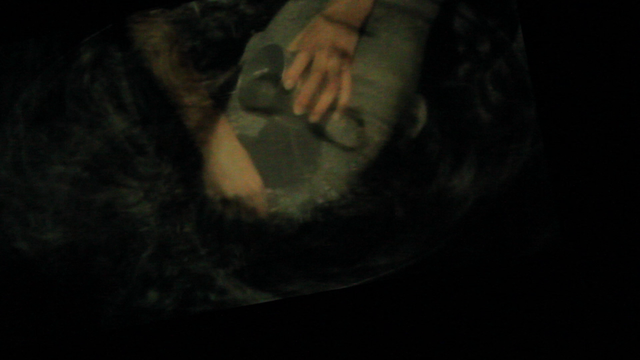
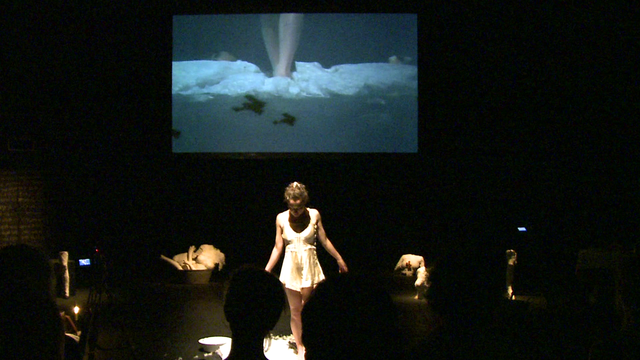
Body
The third part of the intermedial encounter is my body. I used my body in different ways, mainly by improvisation of movement and actions related to the subject matter, objects and images.
In the process of creating the practice, I usually worked alone in the studio; but in the performance itself, I decided to add another body – a hand of a male actor, which appeared beyond the door and operated my own hand. I decided to add another body in order to enlarge the encounter and to add another tension of ‘in-between’ body to body.
During the performance my body shifted its status according to the specific encounter with the objects, images and the other body. Sometimes it was the body that acted upon object or image, operated and generated the encounter and sometimes it was the object or the image that acted upon the body. Each element of the three forms has equal significance in the process of generating a change.
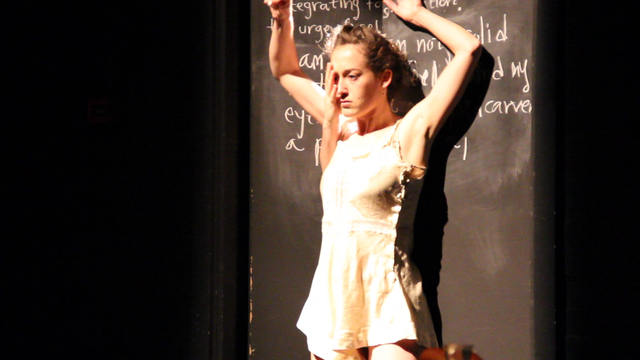
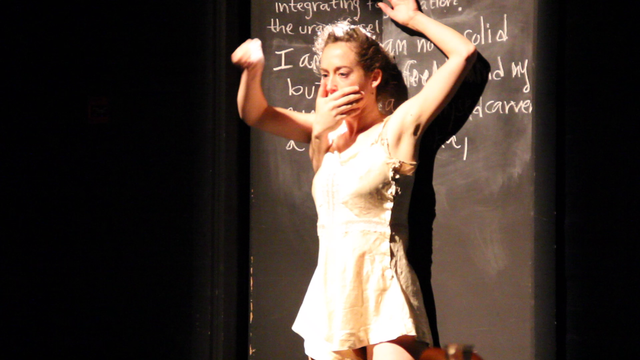
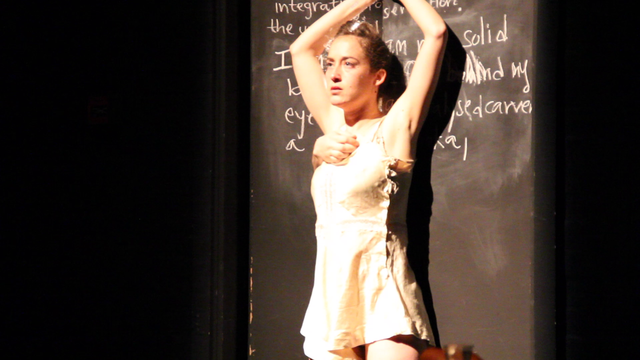
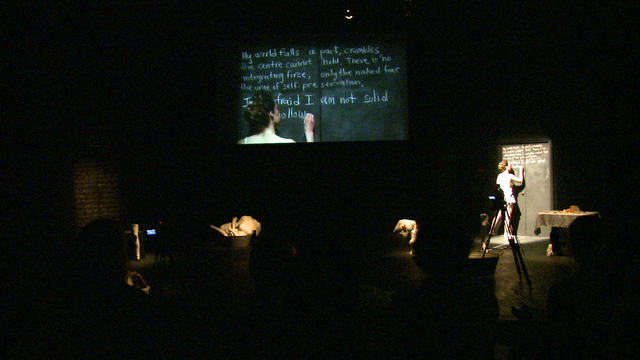
Thesis
On September 2013 I submitted my thesis about “The Modified Encounter – on the relationship between intermediality and memory in performance”.
This exploration is based on the definition of intermediality as a ‘space in between the different realities that the performance creates’ (Chapple & Kattenbelt 2006:12) and on Henri Bergson’s concept of memory as ‘independent recollection’ (Bergson 2011:40) where the virtual past co-exists with the actual present. The purpose of this research is to explore the correspondences between the co-existing realities within intermediality and those that co-exist in memory and the implications these correspondences have on live performance. I apply Jacques Derrida’s notion of différance (Derrida 1991:62) a ‘differentiation that produces the effect of identity and difference between those identities’ (Deutscher 2005:29) as a lens through which I read the differentiation and relations the intermedial encounter creates.
The relationship between intermediality and memory is explored through the development of the intermedial performance practice I am. I am. I am. which focuses on the intermedial encounter between body, image and object and the subject matter of memory. It was through the development and the analysis of I am. I am. I am. that substantial new insights emerged regarding the phenomenon that takes place in the intermedial encounter in relation to memory. The outcomes of this practice as research project show that the relationship between the intermedial encounter and memory is one of correspondence, intensification and modification. The practice shows that the intermedial encounter enacts memory as a creative process in the present moment rather than presenting it as content in the past. The conclusion is that the encounter between intermediality and memory activates and heightens différance and therefore modifies all the elements that participate in the encounter, including memory itself.
Read the full thesis : “The Modified Encounter – on the relationship between intermediality and memory in performance”.
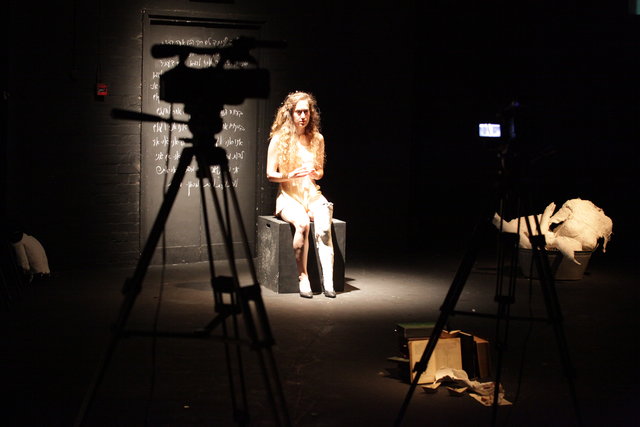
Royal Central School of Speech & Drama website.
To Jo Scott’s blog – about practice & research in the field of intermediality.
Stills photographers: Ruthie Osterman, Samuel Bear Priest, Haitham Assem Tantawy.


